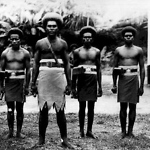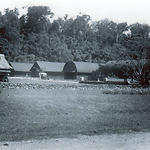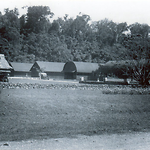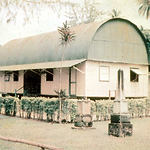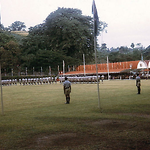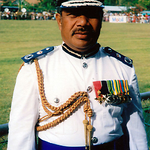Party: Solomon Islands Police Force
- Alternative Names
- Police
Details
The first police in the Protectorate were eight men from Fiji who arrived in late June 1897 as an Armed Constabulary. The first local police were recruited from Malaita, Savo and Ysabel in November 1899 but they were not considered a success. (AR 1897-1898, 12; AR 1899-1900, 15) In 1911, the force was strengthened when twenty-one police from Tanna in the New Hebrides were sent to the Protectorate on a four-year posting. There was talk of replacing them with Indian police, although in the end a local Armed Constabulary was established under Kings Regulations No. 6, of 19 June 1915. By 1922, the constabulary had a strength of 153, with NCOs sent to Fiji for training. (Boutilier 1984b, 45) Police were attached to District Offices, sometimes under a District Officer or at bigger stations a Police Commander. Police could rise through the ranks to Sergeant or Sergeant-Major. In the 1920s, the Police and Prisons Department were administered by the Officer Commanding the Armed Constabulary and Superintendent of Prisons. He was assisted by a European Sub-Inspector of Constabulary and a European Gaoler. By 1929, the Armed Constabulary native personnel consisted of two Sergeant-Majors and 141 of other ranks, and there were eleven warders attached to the gaol. (AR 1927, 9-10, AR 1929, 10) Early police wore a sulu (wrap-around cloth) with a red cumberbund and a belt, the latter often having been obtained as surplus from the Manchester police force and dating to the 1880s. The police carried 303 Lee Enfield rifles while on patrol. (Tedder 2008, 29)
During the Second World War most of the police joined the Solomon Islands Defence Force and many became scouts and coastwatchers (q.v.). The Police Force was reconstituted after the war. Some of the early police were Station Sergeant Samson Sakobose, Corporal Benjamin Pidiri and Constable Simeon Nuno, all from Choiseul, who joined the force on 1 September 1946. Others were Constable Kikoni, Sergeant Jacinth Luta Kusilifu, Chief Warder Tertius Gwangi Babalu and Constable Elija Irotasi Tagina.
A Superintendent of Police was appointed in July 1949. The establishment of the Armed Constabulary at the end of 1950 was three European commissioned officers and 210 sub-officers and constables. The former headquarters was divided into the Police Headquarters and the Police Depot and Training School. Detachments were stationed at the various district administration centres. In addition to Honiara police station, there were police stations at Auki and Malu'u in Malaita District and at Kirakira in Eastern District. Police detachments were also stationed at Gizo and Tataba in Western District. Administrative Officers supervised district establishments. (AR 1949-1950, 30)
The modern Solomon Islands Police Force was established to replace the Armed Constabulary in 1954, based on a Queen's Regulation of 14 November. The approved establishment of the Police Force on 31 December 1954 was eight commissioned officers and two hundred sub-officers and constables. Police Headquarters and the Police Depot and Training School were located at Rove in Honiara. Police formations were located at various district administration centres, and European Commissioned officers were in charge of stations at Honiara and Auki. Police officers were also stationed at Malu'u, at Yandina in the Russell Islands (opened in 1953), and at Gizo and Korovo in Western District (opened in 1954). More emphasis was now placed on literacy for new recruits. Their height had to be at least 1.63 metres (5 feet 4 inches) and it was preferred that they be unmarried. By 1954, a start had been made to establish a Criminal Records Office at Honiara.
The Superintendent of Police remained the Superintendent of Prisons and supervised the Honiara Central Prison. Administrative Officers were in charge of the district prisons at Auki, Malu'u, Gizo and Kirakira. Prisons at Tulagi and Ilu closed in 1949. In the mid-1950s, the Prison Service establishment was the Superintendent and thirty local warders, with the capacity to expand to forty warders. (AR 1953-1954, 35) The size of the force was increased in 1964 by the introduction of a Field Force and a Special Branch Unit. The Field Force supplemented the District Police Stations in patrolling some of the more remote islands and the hinterlands of the main islands. (AR 1963-1964, 57)
New accommodation was built in 1966 behind Central Police Station, consisting of a block for single men and eight married quarters. The first Police Recruits' Training Course passing-out parade occurred at Rove Police Headquarters on 3 June 1964. The examinations were of the same standard as those used in the United Kingdom, and Constable Baekalia earned the top score. By 1966, the Solomon Islands Police Force comprised an establishment of ten gazetted officers and 275 NCO's and other ranks. It was deployed in four Police Districts which coincided with the administrative districts. (AR 1966, 54) As independence approached in the 1970s, there were thirteen gazetted officers, sixteen Inspectors and 328 NCOs, along with seventeen clerical staff. There were fourteen police stations and posts within the four police districts, which coincided with the Protectorate's administrative districts. The headquarters remained at Rove, along with the Police Training School and the Police Mobile Unit. All police stations were linked by a radio network: Honiara, Gizo, Kirakira, Auki and Korovou had 100 watt base sets, while Munda, Ringi Cove, Yandina, Buala, Tulagi, Malu'u, Santa Cruz and Mohawk Bay operated through 15 watt Racal base sets. The Police Training School also trained constables for the Gilbert and Ellice Islands. (AR 1974, 88-89)
Related entries
Published resources
Books
- Tedder, James L.O., Solomon Islands Years: A District Administrator in the Islands, 1952-1974, Tuatu Studies, Stuarts Point, NSW, 2008. Details
Conference Proceedings
- Boutilier, James A. (ed.), The Law of England Has Come: The Application of British and Custom Law in the British Solomon Islands Protectorate, 1893-1942, Association for Social Anthropology in Oceania Annual Conference, Molokai, Hawaii, 28 February to 3 March 1984, 1984b. Details
Reports
- British Solomon Islands Protectorate, British Solomon Islands Protectorate Annual Reports (AR), 1896-1973. Details
Images
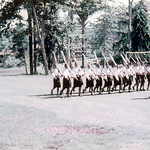
- Title
- Police marching at the Queen's Birthday Parade, Auki, Malaita, 1959
- Type
- Image
- Source
- Alan Lindley
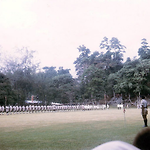
- Title
- Queens Birthday Parade, Rove Police Barracks, Honiara, 1973
- Type
- Image
- Date
- 1973
- Source
- Brian Taylor
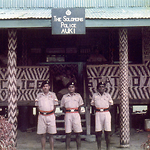
.png)
